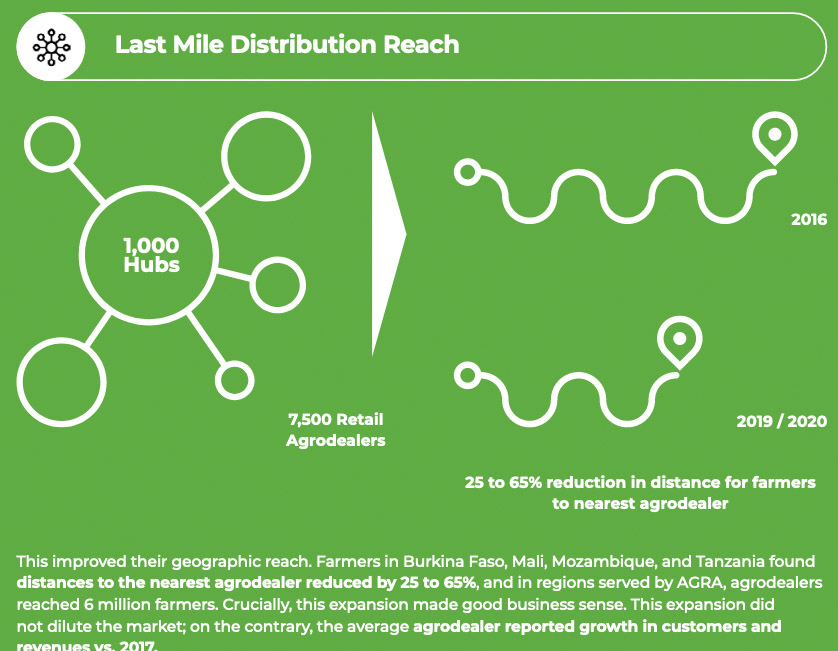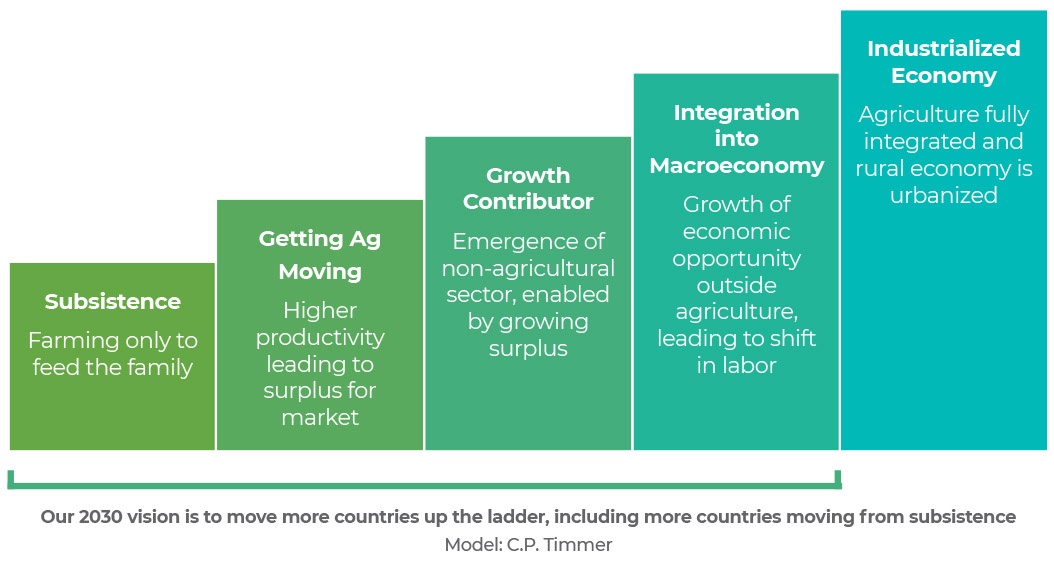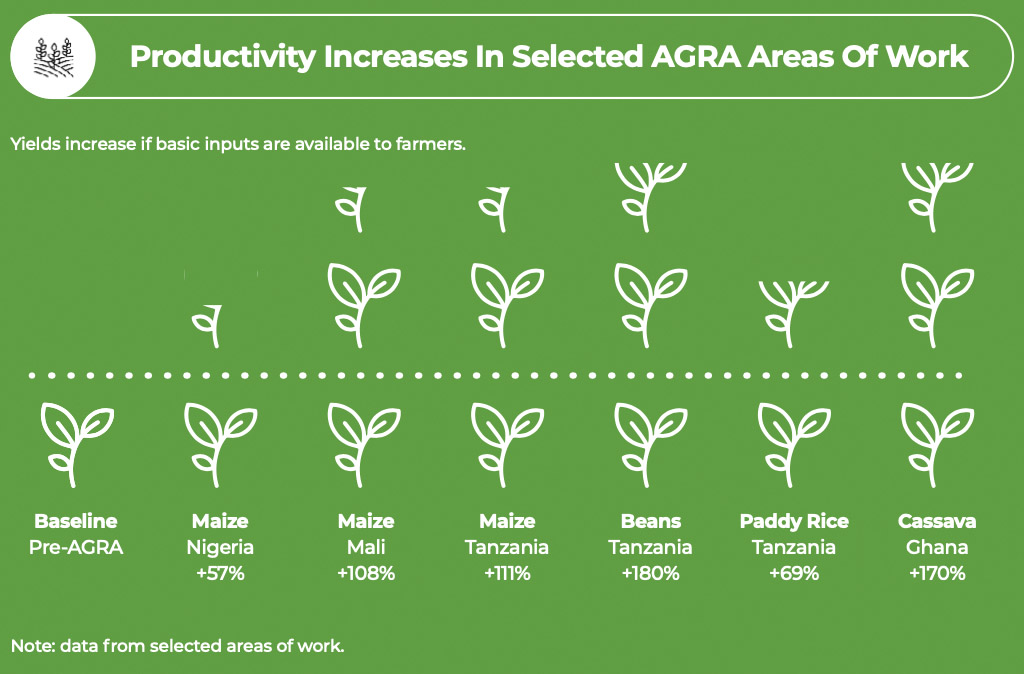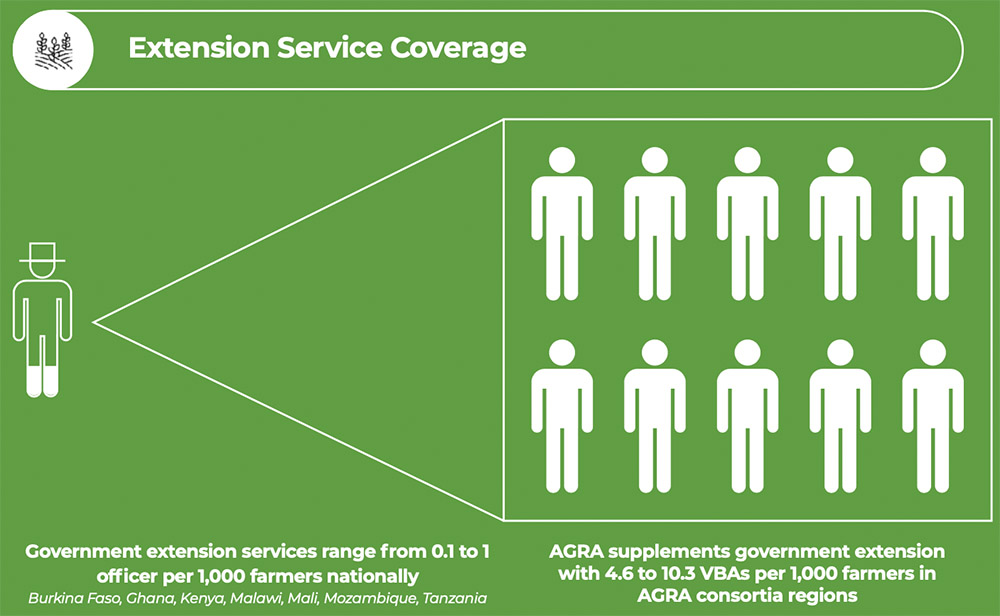Our Impact
Our Vision for Agricultural Transformation
Agriculture provides the primary livelihood for two-thirds of sub-Saharan Africa – yet most farmers live in poverty and most countries struggle with food insecurity. No other sector holds as much potential to improve lives. Our vision is an agriculture transformation that fundamentally changes how food is produced, creating better opportunities in rural economies and providing affordable, nutritious food to the entire population.
This is not just about training smallholders to be better farmers or giving them access to better seeds and fertilizer. Nor is this only about moving harvests from farm to market. Yes, agricultural transformation encompasses such efforts, but goes beyond towards systemic change, where the improvements achieved today can be sustained tomorrow.
We want to change the system – so the subsistence farmer struggling to feed her family joins a vibrant rural economy, and this rural economy improves opportunities both on and off the farm, all of which drives an agricultural sector that feeds the country and accelerates economic diversification and growth.
AGRA supported 11 focus countries and the broader region on the agricultural transformation journey, helping drive systemic changes for businesses, government, and other partners that will lead to improved livelihoods and food security for smallholder farmers.
AGRA Impact 2017-2020

We collaborate with governments to ensure policies and regulations – the rules of the game – make sense. We engage the private sector and find ways to reduce the risks that might deter them from serving farmers.
AGRA’s Strategy for Transformation
Agriculture provides the primary livelihood for two-thirds of sub-Saharan Africa – yet most farmers live in poverty and most countries struggle with food insecurity. No other sector holds as much potential to improve lives. Our vision is an agriculture transformation that fundamentally changes how food is produced, creating better opportunities in rural economies and providing affordable, nutritious food to the entire population.
This is not just about training smallholders to be better farmers or giving them access to better
seeds and fertilizer. Nor is this only about moving harvests from farm to market. Yes, agricultural transformation encompasses such efforts, but goes beyond towards systemic change, where the improvements achieved today can be sustained tomorrow. We want to change the system – so the subsistence farmer struggling to feed her family joins a vibrant rural economy, and this rural economy improves opportunities both on and off the farm, all of which drives an agricultural sector that feeds the country and accelerates economic diversification and growth.
Why AGRA?
Agriculture transformation to impact the lives of smallholder farmers in Africa is a complex matter, in a context of decades of deeply rooted challenges and discouraging setbacks. This is a challenge that requires functioning institutions to build the knowledge and evidence base of what works for farmers, based on the most available science. An ecosystem around the farmer, the private sector and government has to be built.
African leaders, recognizing the challenge, built AGRA to support countries in their own context, under their leadership, to help identify and mobilize the right solutions.
AGRA started with a technology-focused approach that saw many successes. But it learned that it needed to take a more catalytic role, informed by the institutional challenges most African countries had in common.
AGRA now works as an African institution with indigenous expertise, mobilizing the most up-to-date science, partnerships and practice. It has the mission and capabilities to support the transformation African countries need, and their farmers deserve.
Impact on Farmers
What Does it Mean to Change Farmer Livelihoods?
Across our 11 countries, we can see evidence of improved productivity, better crop quality, higher incomes, and more months of food from their surplus. These gains have not been achieved overnight, but rather through carefully targeting and tackling the barriers to meaningful, sustainable change.Building Awareness and Adoption
In 2020 we carried out a rapid assessment of farmers that we work with. We found that since 2017, over 60% of farmers reached by AGRA have adopted new farming practices. While many are now using improved hybrid seeds or fertilizer, we are also observing farmers change how they plant, apply fertilizer, protect their crops, and manage their crops after harvest.
For example, our studies show farmers are making more efficient use of their seed. In Kiambu, Kenya, virtually no farmers used the recommended row and hole spacing or the right number of seeds per hole, leading to significant waste. Following training from our VBAs, all farmers shifted
to best practice. These changes reflect more capable farmers who are applying best practice techniques.
Improving Crop Quality and Production
Better practices are, of course, translating into more productive farms. We can see evidence of higher yields across different countries and crops. For example, Tanzanian farmers supported by AGRA saw dramatic gains in beans and rice yields, while Ghanaian farmers also saw increases in soya and cassava. After just one year, smallholder farmers in Ethiopia reported gains of 5 to 14% for teff, wheat, and haricot beans. Similarly, for the staple maize crop grown across the continent, AGRA’s support also led to increased yields in multiple countries.
Yields are not the only story. Indeed, among our farmers, 67% also reported an improvement in crop quality compared to 2017, while 33% reduced loss and wastage after harvest – keeping more to feed themselves and bring to market.
VBAs reach 6.5 million farmers by delivering critical extension services
Like many farmers in Kiambu County, which borders Kenya’s capital Nairobi, Teresia Njoki was struggling to grow crops that could afford her a comfortable life. Yet for years, she was forced to contend with poor harvests, often losing most of her output after harvest due to lack of handling skills.
Things, however, changed for her in 2019, when she was introduced to better farming practices, inputs and technologies by a Village Based VBAs in Ikihu, the administrative ward she comes from. The VBAs are lead farmers who are recruited and trained by the AGRA to offer extension advice to peers. AGRA identifies and trains the VBAs in partnership with government extension agents.
“Before my VBA came, we had little harvests such that we could not even feed our children adequately. However, we now witness bigger harvests and our children are content. We are also getting surpluses to sell for money to do other things,” said Njoki, who is now receiving up to 2634Kg/ha from as low as 417Kg/ha previously.
Growing Incomes
Among farmers with a surplus harvest to bring to market, 60% reported an increase in income compared to 2017 – and the income increase was substantial, ranging from 20 to over 80% for the majority. The reasons these farmers grew their incomes also underscores the importance and impact of AGRA’s work across multiple dimensions of smallholder farmer needs. For most farmers, this was about increased productivity – but others also found that better access to markets, improved crop quality, higher prices, and more affordable inputs were contributing factors.Increasing Food Security and Resilience
In addition to increasing productivity and incomes of smallholder farmers which in turns builds a buffer of assets and alternative sources of food for farmers and their communities in times of shock, AGRA has been working on integrating regenerative practices into agriculture systems and landscapes to build long term systemic resilience against climate, environmental and some extent market shocks. AGRA’s key Kenyan pilot project on regenerative agriculture, in partnership with the IKEA Foundation has, at its core, the integration and management of natural resources in agriculture landscapes as well as building 2017 a business case for farmer and last mile delivery systems. The nature-based solutions are complimented with access to finance and crop insurance products. In the face of shocks such as COVID-19 AGRA worked with governments to strengthen input and output supply chains and early warning systems that ensure farmer resilience and continued production and supply of food to urban and rural markets.

Impact on Farming Systems
Improving the lives of smallholder farmers means improving the ecosystem around them. Farmers do better when they can access more knowledge, improved inputs, and better markets. Businesses do better when they see growing markets that offer attractive returns.
We make strategic investments into partners and systems in order to create an enabling environment and conditions such that farmers’ capacity is increased, markets can be developed and businesses can grow. Our partners work with local government and farmers’ organizations to build farmer capacity. Some of this is done by VBAs who are selected by the farming communities themselves. Other partners work with offtakers to link demand and supply and therefore grow demand. Other partners introduce financial instruments and insurance to de-risk activities. Through this process, businesses are built.
Like any ecosystem, the parts of the agricultural sector must work in concert. A breakdown in one area has ripple effects elsewhere – but effective change creates a virtuous cycle that strengthens all parts of the ecosystem.
Reaching Farmers, Building Capacity
Agricultural extension workers are a high-impact tool who can deliver training, seed and fertilizer samples, conduct field demonstrations, and more to help improve how smallholders farm. Unfortunately, many governments have underinvested in extension services, and most countries have less than one extension worker per 1000 farmers. To supplement government extension, AGRA scaled up VBAs extension programs, providing 5 to 10 VBAs per 1000 farmers in the regions we reached. These VBAs provided sample inputs, agronomic advice, and post-harvest services, building farmer capacity and developing market demand. And they have proved the model effective: farmers who adopted better technologies were 2 to 3x more likely to have been influenced by a VBA than by a neighbor or the media.
Productivity Through Access and Choice of Inputs for Smallholder Farmers
As VBAs helped train smallholder farmers on better technologies and practices, AGRA worked with partners such as the National Research Institutes, private seed companies, and CGIAR to deliver better seeds, better fertilizers, and new ways of applying fertilizers to increase farm labor productivity and to ensure strong supply capacity to farmers. Through these partners, we have supported the development and commercialization of over 400 seed varieties, from chickpeas, groundnut and sweet potato to millet, rice, and maize. To improve fertilizer use efficiency in farmers’ fields, we have supported soil mapping activities by working with local small blending companies, and in some cases larger ones like YARA and OCP, to develop 29 blends appropriate for local growing conditions and farmers’ production objectives. This gives farmers choices.
Distributing to the Last Mile
Seed and fertilizer SMEs in Africa will only thrive if they have ways to reach their customer. Historically, the challenge for these SMEs who form the retail channels that can reach farmers, is that “last mile” distribution may not be profitable. This leaves farmers – most of whom lack easy transport options – far from the goods they need. By developing the market through agrodealers and VBAs and expanding
input supply, AGRA has laid the groundwork for broader distribution.

Case Study
Rwandan Seed System
Historically, Rwanda’s seed system was underdeveloped, leaving farmers highly dependent on imports or open- pollinated varieties. AGRA worked with the Ministry of Agriculture in Rwanda to design the seeds system. There was government commitment to developing the system. AGRA catalyzed change through systematic investments training: support of local scientists and researchers, development of 47 varieties of seed for local conditions, and support of domestic breeding and certified seed production. AGRA supported business development but also quality control. Rwandan farmers now source 80% of seed locally, leading to job creation, particularly for women, who are often hired for seed sorting positions. During March-July 2020, the country
achieved self-sufficiency in hybrid maize seed adding to its strong bean and potato seed base.





